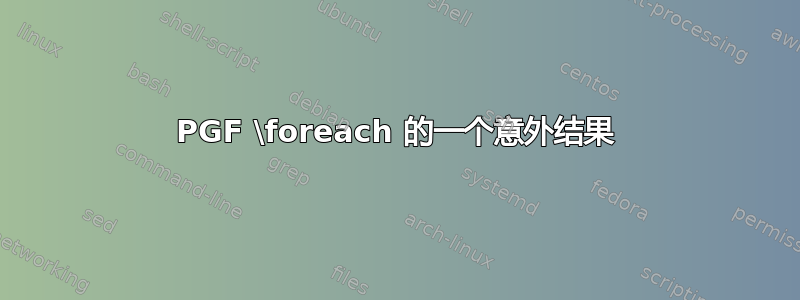
以下来自 PGF 手册 2.40 第 508 页的示例给出了我意想不到的结果。
\tikz[x=0.75cm,y=0.75cm]
\foreach \x [count=\xi] in {a,...,e}
\foreach \y [count=\yi] in {\x,...,e}
\node [draw, top color=white, bottom color=blue!50, minimum size=0.666cm]
at (\xi,-\yi) {$\mathstrut\x\y$};

我期望看到bc,,,,bdbecdce我de期望
以下给出预期的输出:
\tikz[x=0.75cm,y=0.75cm]
\foreach \x [count=\xi] in {1,...,5}
\foreach \y [count=\yi] in {\x,...,5}
\node [draw, top color=white, bottom color=blue!50, minimum size=0.666cm]
at (\xi,-\yi) {$\mathstrut\x\y$};

我猜\foreach。
我自己的\newforeach给了

使用代码
\tikz[x=0.75cm,y=0.75cm]
\newforeach [count=\xi] \x in {a,...,e}
\newforeach [count=\yi,expand before fill] \y in {\x,...,e}
\node [draw, top color=white, bottom color=blue!50, minimum size=0.666cm]
at (\xi,-\yi) {$\mathstrut\x\y$};
最后一个输出正是我所期望的\foreach。遗憾的是,\newforeach尚未发布,因为它仍在测试中。您可以索取并参与测试。
答案1
如果你试试
\foreach \x [count=\xi] in {1,...,5}
\foreach \y [count=\yi] in {\x,...,5}
那么一切都很好:问题在于\foreach代码处理字母迭代的方式存在错误。相关代码是
\def\pgffor@makealphabetic#1{%
% Convert the number in the macro passed as #1 to a-z or A-Z.
\pgfutil@tempcnta=#1\relax%
\ifnum\pgfutil@tempcnta>95\relax%
\advance\pgfutil@tempcnta by-96%
\expandafter\def\expandafter#1\expandafter%
{\pgffor@alpha\pgfutil@tempcnta}%
\else%
\advance\pgfutil@tempcnta by-64%
\expandafter\def\expandafter#1\expandafter%
{\pgffor@Alpha\pgfutil@tempcnta}%
\fi%
}
这里,#1是用于保存将要打印/使用的临时变量\x,,\yETC。它是一个数字,但上面的代码将其转换为字母。但是,上面的代码并没有正确地做到这一点:所有这些\expandafters 都没有扩展\pgfutil@tempcnta,而这实际上是需要的。对我来说
\def\pgffor@makealphabetic#1{%
% Convert the number in the macro passed as #1 to a-z or A-Z.
\pgfutil@tempcnta=#1\relax%
\ifnum\pgfutil@tempcnta>95\relax%
\advance\pgfutil@tempcnta by-96\relax%
\edef#1{\pgffor@alpha\pgfutil@tempcnta}%
\else%
\advance\pgfutil@tempcnta by-64\relax%
\edef#1{\pgffor@Alpha\pgfutil@tempcnta}%
\fi%
}
解决了该问题,因为字母现在已经“烘焙”好了。
(我没有彻底追踪它,但我的猜测是,在明确的迭代列表中,不涉及数字部分,因此只有在使用...符号时才能看到这一点。)
在这里完全禁用转换是非常有启发性的:
\documentclass{article}
\usepackage{tikz}
\makeatletter
\def\pgffor@makealphabetic#1{}
\makeatother
\begin{document}
\tikz[x=0.75cm,y=0.75cm]
\foreach \x [count=\xi] in {a,...,e}
\foreach \y [count=\yi] in {\x,...,e}
\node [draw, top color=white, bottom color=blue!50, minimum size=0.666cm]
at (\xi,-\yi) {$\mathstrut\x\y$};
\end{document}
这表明\foreach第一种情况的处理方式与所有其他情况是分开的。我不确定这是否是一个好计划,因为它留下了行为变化的风险。


